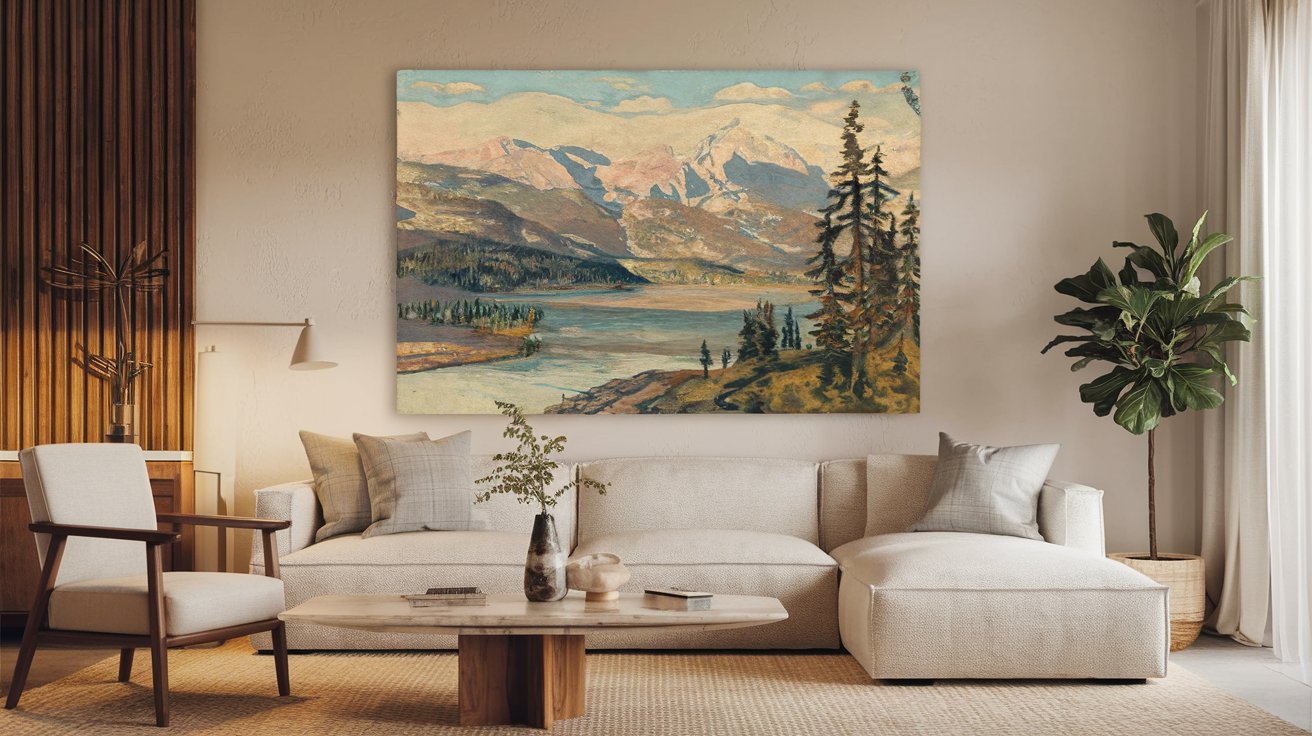Table of Contents
Caring for vintage wall art Collection requires meticulous attention to detail and a deep understanding of the factors that can damage or preserve your collection. Whether you’re an experienced art collector or new to preserving valuable pieces, proper care can significantly extend the life of your vintage art. In this guide, we cover everything you need to know about maintaining the quality and integrity of your collection.

Understanding the Nature of Vintage Wall Art
Vintage wall art Collection, ranging from paintings and prints to sculptures and tapestries, is often made from materials that naturally degrade over time. Different mediums such as oil, acrylic, wood, or fabric require specific care. The key to preservation lies in understanding the vulnerabilities of these materials.
Identifying Medium-Specific Preservation Needs
Paintings and Canvas Art
Paintings on canvas are vulnerable to dust, moisture, and light exposure. Paint pigments can fade, and canvas fibers can weaken if not properly maintained.
- Dust Removal: Use a soft, dry microfiber cloth to gently clean the surface. Avoid using water or chemical cleaners, which can damage the pigments.
- Humidity Control: Keep paintings in a stable environment with humidity levels between 40% and 60%. High humidity can cause mold growth, while low humidity may cause the canvas to dry out and crack.
- UV Protection: Hang paintings away from direct sunlight to prevent fading. You can also invest in UV-protective glass or acrylic frames.
Metal Art and Sculptures
Metal sculptures can tarnish, rust, or corrode over time, particularly if they are displayed in high-moisture areas.
- Cleaning Metals: Use a damp cloth with mild soap for cleaning. Dry thoroughly to prevent moisture buildup.
- Polishing: Occasionally polish metal sculptures with a non-abrasive metal polish, but avoid over-polishing as it can remove protective coatings or patinas.
Wood Art and Tapestries
Wood and fabric are particularly sensitive to environmental changes, pests, and handling. Fluctuating humidity levels can cause wooden frames to warp, crack, or develop mold, compromising the structural integrity of your artwork. Fabric-based pieces, such as tapestries or mixed-media art, are prone to fading, fiber deterioration, and pest infestations, especially from moths and silverfish. Improper handling and storage can lead to tears, stains, and permanent creases. To ensure long-term preservation, keep wood and fabric artwork in a climate-controlled environment, inspect them for signs of deterioration, and use archival-quality materials for storage and framing.
- Dusting Wood Surfaces: Use a dry, soft-bristle brush to remove dirt and dust from wooden frames and sculptures.
- Fabric Care: Vacuum tapestries on a low setting to avoid pulling on fibers. When possible, rotate tapestries to reduce wear from sunlight and air exposure.
Controlling Environmental Factors
Preserving your vintage wall art collection starts with controlling the environment where the pieces are stored or displayed. Environmental factors, including light, temperature, and humidity, have a significant impact on the longevity of your art collection. Excessive humidity can lead to mold growth, warping, and paint deterioration, while low humidity can cause cracking and brittleness. Direct sunlight and UV exposure accelerate color fading and surface damage, making proper lighting essential. To protect your artwork, maintain stable climate conditions, use UV-filtering glass, ensure proper ventilation, and avoid placing pieces near heat sources or damp areas to prevent deterioration.
Optimal Lighting Conditions
Excessive light exposure, particularly UV light, can cause irreversible fading and deterioration. Even artificial lighting can be harmful if not managed properly.
- Avoid Direct Sunlight: Always hang art away from direct sunlight or windows. If exposure to light is unavoidable, use UV-filtering window film or blinds.
- Use LED Lighting: LED lights emit minimal UV rays and heat, making them ideal for lighting art. Position lights at a safe distance to avoid heat damage.
Temperature and Humidity Management
Fluctuating temperatures and humidity levels can cause warping, cracking, and other forms of damage. It’s essential to maintain stable conditions.
- Temperature Control: Keep the temperature in your art display or storage area between 18°C and 22°C (65°F to 72°F). Avoid placing art near heating vents or air conditioners.
- Humidity Control: Use a dehumidifier or humidifier to keep the relative humidity level stable. Avoid placing art in basements or attics where humidity is harder to control.
Proper Handling and Storage Techniques
Even with the best environmental controls, improper handling or poor storage conditions can severely damage a vintage wall art collection. Careful handling and strategic storage are essential to preventing unnecessary wear and tear. Frequent touching can transfer oils and dirt onto the art surface, leading to staining and deterioration. Stacking or placing artwork in tight spaces without protection can cause scratches, pressure marks, and frame damage. Always use clean, dry hands or gloves when handling pieces, and store them in climate-controlled spaces with protective materials, such as acid-free paper, sturdy backing, and padded supports, to ensure long-term preservation.
Safe Handling Practices
- Wear Gloves: Always wear clean cotton gloves when handling valuable art to prevent oils and dirt from your skin from transferring onto the surface.
- Support the Frame: When moving framed art, always support the frame from the bottom rather than holding it by the top or sides, which can weaken joints.
Storage Guidelines for Long-Term Preservation
For art that isn’t on display, proper storage is essential.
- Flat Storage for Works on Paper: Store prints, photographs, and works on paper flat, in acid-free folders, within archival boxes.
- Upright Storage for Paintings: Store canvas works upright, ensuring they are well-spaced to avoid accidental scratches. Use felt spacers between pieces.
- Avoid Damp Spaces: Never store art in areas prone to dampness, such as basements or garages. Use climate-controlled storage units when possible.
Routine Maintenance and Inspections
Regular inspections and routine maintenance are essential for preserving vintage wall art and detecting potential issues before they become serious problems. Over time, dust accumulation, moisture exposure, and pest infestations can cause gradual deterioration. Examining your art collection periodically helps identify early signs of fading, cracking, warping, or mold growth. Pay close attention to wooden frames, canvas tension, and surface discoloration. Gently dust and clean artwork using soft, non-abrasive materials, and consult a professional conservator for delicate restorations. By maintaining a proactive care routine, you can extend the lifespan of your valuable pieces and keep them in pristine condition.
Annual Cleaning and Inspection Checklist
- Check for Cracking or Fading: Examine paintings for cracks in the paint or canvas and check for fading colors.
- Inspect for Mold or Mildew: Especially in high-humidity environments, look for signs of mold or mildew on both the art and the frame.
- Evaluate Frames: Inspect wooden frames for signs of warping or pest damage. Metal frames should be checked for rust or tarnish.
- Rotate Pieces: If your vintage art is in constant display, rotating the pieces can prevent overexposure to light and air.
Vintage Wall Art Collection, Vintage Wall Art Collection, Vintage Wall Art Collection, Vintage Wall Art Collection, Vintage Wall Art Collection, Vintage Wall Art Collection, Vintage Wall Art Collection, Vintage Wall Art Collection.
Conclusion
Preserving your vintage wall art collection requires a combination of environmental controls, careful handling, and proactive maintenance. By maintaining optimal conditions, such as stable humidity, controlled temperature, and proper lighting, you can protect your artwork from fading, warping, and deterioration. Additionally, regular inspections help identify early signs of damage, allowing for timely restoration and preventive care. Using archival-quality materials, safe storage solutions, and professional conservation techniques will further ensure the longevity and value of your art collection. With proper care, your vintage pieces can remain vibrant and well-preserved, ready to be enjoyed by future generations.
FAQ
- How can I protect vintage artwork from direct sunlight?
- Use UV-filtering acrylic glass or varnish to prevent fading and damage from ultraviolet rays.
- What is the ideal temperature for storing old artwork?
- Maintain a stable temperature between 72°F and 75°F (22°C to 24°C) to avoid cracking or damage from thermal fluctuations.
- How can I reduce humidity around my wall art collection?
- Invest in a high-quality dehumidifier to maintain low humidity levels and prevent mold or warping of materials.
- Is it better to store paintings horizontally or vertically?
- Always store your artworks vertically to prevent canvases from sagging or losing their shape.
- What materials should I use to frame and preserve vintage wall art?
- Opt for acid-free framing materials, such as pH-neutral paper and backing boards, to prevent yellowing and deterioration.
- How can I clean an old painting without damaging it?
- Use a soft, dry cloth to remove dust, and avoid any harsh chemical products that could harm the painted surface.
- What should I do if my painting shows signs of cracking or peeling?
- Consult a conservation specialist to stabilize the artwork with appropriate adhesives or other professional techniques.
- Can I restore a damaged wall mural myself?
- Complex restorations involving pigments or plaster should be entrusted to experts to preserve the authenticity of the piece.
- How can I prevent damage when transporting vintage artwork?
- Carefully wrap your artworks with acid-free paper, bubble wrap, and use reinforced boxes designed for secure transport.
- What are the best places to display my vintage wall art at home?
- Choose a wall away from heat sources, moisture, and direct sunlight to preserve your artworks over time.
